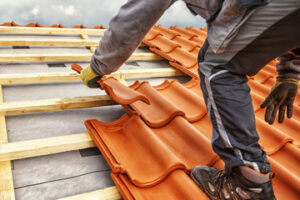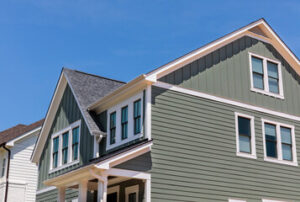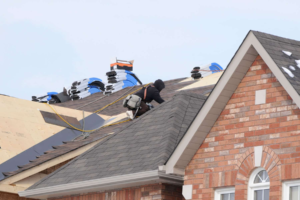There are many more roofing options available to homeowners than ever before. Homeowners can weigh the pros and cons of various materials and choose a style that suits their taste as well as their budget.
A roof is the top covering of a building or home, supported on its walls and uprights, that protects against rain, snow, sunlight, extreme temperatures, and wind. Click the https://www.delaware-roofing.com/ to know more.

There are a variety of roofing materials that homeowners can choose from, depending on their budget and style. While some roofs are better suited for certain climates, all of the options will provide protection from moisture and weather elements.
Choosing the right roof material can make or break your home’s overall appearance and resale value. Some of the most popular materials include shingles, clay tiles, and metal roofs. Other options include a green roof, which is a living roof made from vegetation that helps with water runoff and filtration and puts clean oxygen back into the air.
Asphalt shingle roofs are the most popular type of roofing in America, and there are several different styles to choose from. These shingles are inexpensive and easy to install, but they do not offer the same durability as other types of roofs or add much to a home’s resale value.
Clay tiles are another durable option that can be glazed to add a bit of flair to your home. These tiles can be quite expensive but they will last for upwards of 50 years. One disadvantage of these roofs is that they can be heavy, putting stress on your house structure, and may require extra support.
Concrete tiles are similar to clay but are less expensive and can be installed in a variety of styles. This roof material can last upwards of 50 years and is a good choice for hot climates, although it does require additional support to prevent it from bending and cracking.
Metal roofing is also a highly durable option that can add a unique look to your home. This is not a cheap roof, but it will last for decades and can add significant value to your home. It is also a great choice for coastal areas, as it can withstand high winds and salty air.
Wood shingles and shakes are a traditional choice that can give your home a classic, rustic look. These shingles are typically made from cedar but can also be found in redwood and southern pine. While shingles are sawed into a uniform shape, shakes are split into wedges to produce a more rugged look.
Installation
The roof is the top covering of a building, protecting against rain, snow, sunlight, wind, and extreme temperatures. It is a crucial part of any structure, and it comes in a wide variety of forms. Whether new construction or a re-roof, roofing is a meticulous process that requires a great deal of skill and attention to detail.
Before the shingles are installed, roofers must prepare the surface. They will tarp or cover anything that is not on the roof and move things like sprinklers, plants, and vehicles to keep them safe from falling debris. A thorough inspection of the existing roof is also necessary to ensure that it will support the weight of the new shingle layer.
To install the underlayment and shingles, roofers use a variety of standard tools including hammers, a nail gun, ladders, shingle cutters, a caulk gun, and a handful of other hand tools. They may also employ the use of a large vehicle for larger jobs that require a lot of transportation of materials. They will apply a waterproofing material to the raw edges of the roof to prevent water from seeping into places it shouldn’t be. They will then lay down the first row of shingles, nailing them in place with a pattern that involves close nails near the edge and then spreading out more as you move towards the middle.
Maintenance
A roof is an important part of a building that provides protection against rain, snow, sunlight, wind, and extremes of temperature. It can be constructed in a wide variety of forms, including flat, pitched, vaulted, or domed, as dictated by technical, economic, or aesthetic considerations. It is also an integral component of many types of structures, from homes to office buildings and hospitals.
The proper maintenance of a roof requires frequent inspections to identify and repair problems before they cause significant damage or leakage. These procedures should be carried out by trained roofing professionals, preferably on a twice-yearly basis, in the spring and fall, or after major weather events.
These inspections should include a careful examination of the shingles to detect any that are excessively worn or damaged, as well as checking caulking around chimneys and vent pipes to ensure they are still intact. Also look for moss growth, which can lead to material degradation and leaks. Finally, a good inspection should include a review of the roof drains to make sure they are free of debris.
Other tasks that should be performed regularly to maintain the condition of a roof include trimming tree branches that overhang the roof, cleaning out gutters, and ensuring there are no leaks in the flashing (a piece of galvanized metal installed at joints where roofing planes meet). If a roof is covered by vegetation, it is necessary to periodically remove it to prevent plant roots from penetrating the waterproofing layer and causing damage.
It is a good idea to keep a logbook or digital file containing records of inspections, repair details, and other significant observations. This documentation can be valuable in the event of a warranty claim or when selling a home, as it demonstrates that the roof has been properly maintained.
The roofing industry has developed a wide variety of materials and installation techniques, ranging from traditional shingle roofs to green or “living” roofs made of cut turf and other plants. These are becoming increasingly popular, as they provide insulating value and reduce the amount of rainwater that enters buildings. In addition, they can help to mitigate the effects of global warming.
Repairs
There are two main ways of repairing roof damage: replacing the damaged shingles and adding a second layer of shingles (known as re-roofing). Replacing involves removing all of the existing shingle overlay or roofing materials, and then installing new ones. Re-roofing is a less comprehensive option, but it’s still time-consuming and labor-intensive.
Both methods have their pros and cons, and the cost of a repair job depends on many factors. The type of repair, the amount of work involved, and the materials used all play a role in determining the final price of the job. The location of the repairs also influences the cost, since more difficult to reach parts of the roof can be more expensive than easier areas. Steep or steeper roofs may require extra safety measures and equipment, which can also affect the final price of the project.
A common type of roofing repair is the replacement or repair of pipe collars, which are metal fittings that help vent household appliances like water heaters and dryers. These are often found on the attic floor of a home, and if their flashing is damaged or deteriorates over time, they can become a primary entry point for water into the house. A repair process for this issue includes a thorough inspection of the entire assembly to assess any damage and determine the best course of action.
This involves a close examination of the metal collar, rain cap, and storm collar components, as well as the base flashing. Any of these parts that are worn, deteriorating, or loose can be replaced or repaired, with special care taken to ensure they are properly aligned and sealed to prevent future leaks. Once the collar is completely reassembled, a layer of new shingles is installed on top to integrate seamlessly with the existing roof.
The final step in this type of repair is laying down a second layer of shingles to cover the existing ones, and this can be tricky. First, the old shingles have to be removed with precision to avoid damaging unaffected shingles. And then, the shingles must be tightly laid and carefully matched to the color of the adjacent shingles.








